Related Research Articles

Apus is a small constellation in the southern sky. It represents a bird-of-paradise, and its name means "without feet" in Greek because the bird-of-paradise was once wrongly believed to lack feet. First depicted on a celestial globe by Petrus Plancius in 1598, it was charted on a star atlas by Johann Bayer in his 1603 Uranometria. The French explorer and astronomer Nicolas Louis de Lacaille charted and gave the brighter stars their Bayer designations in 1756.
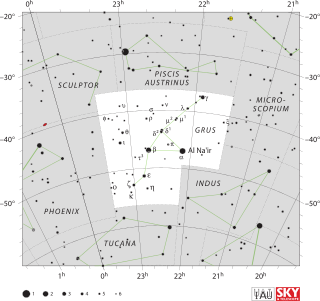
Grus is a constellation in the southern sky. Its name is Latin for the crane, a type of bird. It is one of twelve constellations conceived by Petrus Plancius from the observations of Pieter Dirkszoon Keyser and Frederick de Houtman. Grus first appeared on a 35-centimetre-diameter (14-inch) celestial globe published in 1598 in Amsterdam by Plancius and Jodocus Hondius and was depicted in Johann Bayer's star atlas Uranometria of 1603. French explorer and astronomer Nicolas-Louis de Lacaille gave Bayer designations to its stars in 1756, some of which had been previously considered part of the neighbouring constellation Piscis Austrinus. The constellations Grus, Pavo, Phoenix and Tucana are collectively known as the "Southern Birds".

Hydrus is a small constellation in the deep southern sky. It was one of twelve constellations created by Petrus Plancius from the observations of Pieter Dirkszoon Keyser and Frederick de Houtman and it first appeared on a 35-cm (14 in) diameter celestial globe published in late 1597 in Amsterdam by Plancius and Jodocus Hondius. The first depiction of this constellation in a celestial atlas was in Johann Bayer's Uranometria of 1603. The French explorer and astronomer Nicolas Louis de Lacaille charted the brighter stars and gave their Bayer designations in 1756. Its name means "male water snake", as opposed to Hydra, a much larger constellation that represents a female water snake. It remains below the horizon for most Northern Hemisphere observers.

Johann Bayer was a German lawyer and uranographer. He was born in Rain, Lower Bavaria, in 1572. At twenty, in 1592 he began his study of philosophy and law at the University of Ingolstadt, after which he moved to Augsburg to begin work as a lawyer, becoming legal adviser to the city council in 1612.
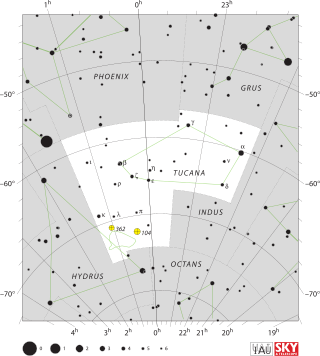
Tucana is a constellation of stars in the southern sky, named after the toucan, a South American bird. It is one of twelve constellations conceived in the late sixteenth century by Petrus Plancius from the observations of Pieter Dirkszoon Keyser and Frederick de Houtman. Tucana first appeared on a 35-centimetre-diameter (14 in) celestial globe published in 1598 in Amsterdam by Plancius and Jodocus Hondius and was depicted in Johann Bayer's star atlas Uranometria of 1603. French explorer and astronomer Nicolas Louis de Lacaille gave its stars Bayer designations in 1756. The constellations Tucana, Grus, Phoenix and Pavo are collectively known as the "Southern Birds".
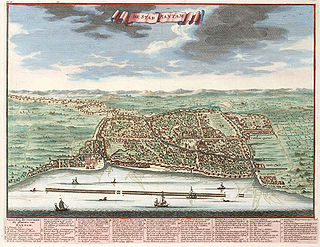
1603 (MDCIII) was a common year starting on Wednesday of the Gregorian calendar and a common year starting on Saturday of the Julian calendar, the 1603rd year of the Common Era (CE) and Anno Domini (AD) designations, the 603rd year of the 2nd millennium, the 3rd year of the 17th century, and the 4th year of the 1600s decade. As of the start of 1603, the Gregorian calendar was 10 days ahead of the Julian calendar, which remained in localized use until 1923.
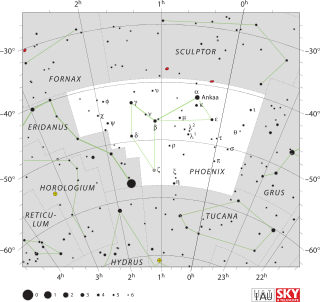
Phoenix is a minor constellation in the southern sky. Named after the mythical phoenix, it was first depicted on a celestial atlas by Johann Bayer in his 1603 Uranometria. The French explorer and astronomer Nicolas Louis de Lacaille charted the brighter stars and gave their Bayer designations in 1756. The constellation stretches from roughly −39° to −57° declination, and from 23.5h to 2.5h of right ascension. The constellations Phoenix, Grus, Pavo and Tucana, are known as the Southern Birds.
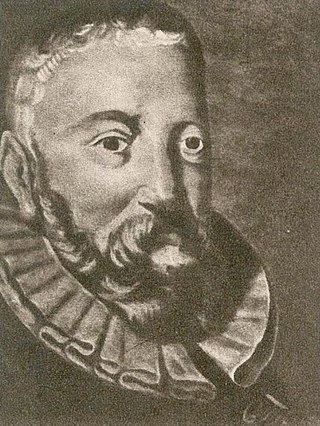
Cornelis de Houtman was a Dutch merchant seaman who commanded the first Dutch expedition to the East Indies. Although the voyage was difficult and yielded only a modest profit, Houtman showed that the Portuguese monopoly on the spice trade was vulnerable. A flurry of Dutch trading voyages followed, eventually leading to the displacement of the Portuguese and the establishment of a Dutch monopoly on spice trading in the East Indies.

Volans is a constellation in the southern sky. It represents a flying fish; its name is a shortened form of its original name, Piscis Volans. Volans was one of twelve constellations created by Petrus Plancius from the observations of Pieter Dirkszoon Keyser and Frederick de Houtman and it first appeared on a 35-cm diameter celestial globe published in 1597 in Amsterdam by Plancius with Jodocus Hondius. The first depiction of this constellation in a celestial atlas was in Johann Bayer's Uranometria of 1603.

Musca is a small constellation in the deep southern sky. It was one of 12 constellations created by Petrus Plancius from the observations of Pieter Dirkszoon Keyser and Frederick de Houtman, and it first appeared on a celestial globe 35 cm (14 in) in diameter published in 1597 in Amsterdam by Plancius and Jodocus Hondius. The first depiction of this constellation in a celestial atlas was in Johann Bayer's Uranometria of 1603. It was also known as Apis for 200 years. Musca remains below the horizon for most Northern Hemisphere observers.

Pavo is a constellation in the southern sky whose name is Latin for "peacock". Pavo first appeared on a 35-cm (14 in) diameter celestial globe published in 1598 in Amsterdam by Plancius and Jodocus Hondius and was depicted in Johann Bayer's star atlas Uranometria of 1603, and was likely conceived by Petrus Plancius from the observations of Pieter Dirkszoon Keyser and Frederick de Houtman. French explorer and astronomer Nicolas-Louis de Lacaille gave its stars Bayer designations in 1756. The constellations Pavo, Grus, Phoenix and Tucana are collectively known as the "Southern Birds".
This article presents lists of the literary events and publications in 1603.
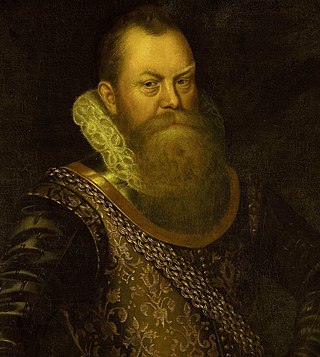
Frederick de Houtman was a Dutch explorer, navigator, and colonial governor who sailed on the first Dutch expedition to the East Indies from 1595 until 1597, during which time he made observations of the southern celestial hemisphere and contributed to the creation of 12 new southern constellations.
The year 1627 in science and technology involved some significant events.
The year 1619 in science and technology involved some significant events.

Petrus Plancius was a Dutch-Flemish astronomer, cartographer and clergyman. He was born as Pieter Platevoet in Dranouter, now in Heuvelland, West Flanders. He studied theology in Germany and England. At the age of 24 he became a minister in the Dutch Reformed Church.
Pieter Dirkszoon Keyser was a Dutch navigator and celestial cartographer who mapped several constellations on the southern celestial hemisphere.
The year 1597 in science and technology involved some significant events.
The year 1571 in science and technology included a number of events, some of which are listed here.
The year 1540 in science and technology included a number of events, some of which are listed here.
References
- ↑ Asimov, Isaac. Asimov's Biographical Encyclopedia of Science and Technology (2nd ed.).
- ↑ As a supplement to his grammar and dictionary of the Malay and Malagasy languages, de Houtman, Fr. (1603). Spraeck ende woord-boeck, in de Maleysche ende Madagaskarsche talen, met vele Arabische ende Turcsche woorden. Inhoudende twaelf tsamensprekeninghen inde Maleysche, ende drie in de Madagaskarsche spraken, met alderhande woorden ende namen, ghestela naer dordre vanden A.B.C. alles int Nederduytsch gestellt: noch zijn hier byghevoecht de declinatien van vele vaste Sterren, staende ontrent den Zuyd-pool. Amsterdam: Jan Evertsz. Cloppenburch. Retrieved 2012-01-02.
- ↑ Crilly, Tony (2007). 50 Mathematical Ideas you really need to know. London: Quercus. p. 41. ISBN 978-1-84724-008-8.